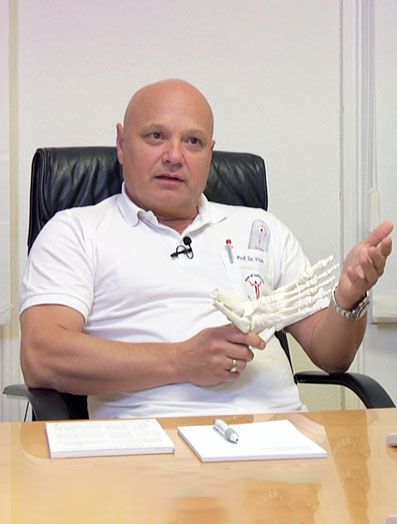Flat foot
Or: Pes Planus, Pes Planovalgus
The further intensification of the skewed and of the skewed flat foot, the flat foot is the opposite of the hollow foot.
The longitudinal arch of the foot is totally flat when standing and comes in contact with the ground. The heel position points outwards, while it is mostly inwards in a hollow foot.
The forefoot, in contrast to the hollow foot, is rotated on its own longitudinal axis to the inside. Like the hollow foot, the flatfoot can be congenital or acquired.
The causes range from genetic factors, from connective tissue weakness to inflammation, stress and obesity.
Treatment principle
Children
The loose (flexible), childlike skewed flat foot needs treatment using special inserts to prevent the transition to the rigid flat foot, which may result from the contraction of tendons and ligaments.
The severe childhood flatfoot with the so-called vertical talus must be operated.
Adult
In adulthood, in case of a failure of conservative treatment, the flatfoot can occur due to overstretching or sneaking cracks in the major tendons that support and stretch the longitudinal arch. The most important of these tendons is the tendon of the posterior calf muscle (tibialis posterior).
The adult flatfoot can be treated with operational measures such as tendon transfers, extension and displacement operations on the heel, arch-lifts and tarsal stiffening to choose from.
Example I:
Flat foot:
Picture 1: The patient suffers from pain, the intense conservative treatment did not help.
Picture 2: The footprint shows the full contact of the foot.
Picture 3: Operative extension of the heel bone, which also moves more into the middle, and so the foot is straightened.
Picture 4: The correction is maintained by a special plate. Since it does not trouble much, it can usually be left there.
Picture 5: Nicely straightened longitudinal arch. The patient was pain-free after surgery
Another case
In case of this patient, the foot has slumped dramatically towards the inside so that she could no longer walk more than a few steps.
Picture 1: The arch of this foot has collapsed completely.
Picture 2: The foot is grotesquely deformed.
Picture 3: Here we had to straighten the tarsal joints and stiffen them.
Picture 4: Afterwards the patient has a normal foot again and can walk long distances without discomfort.



